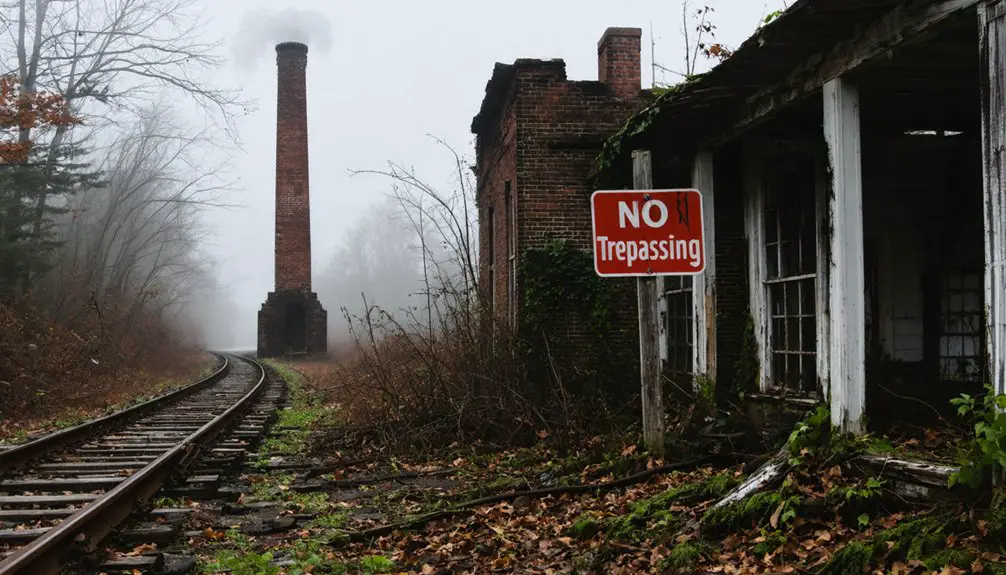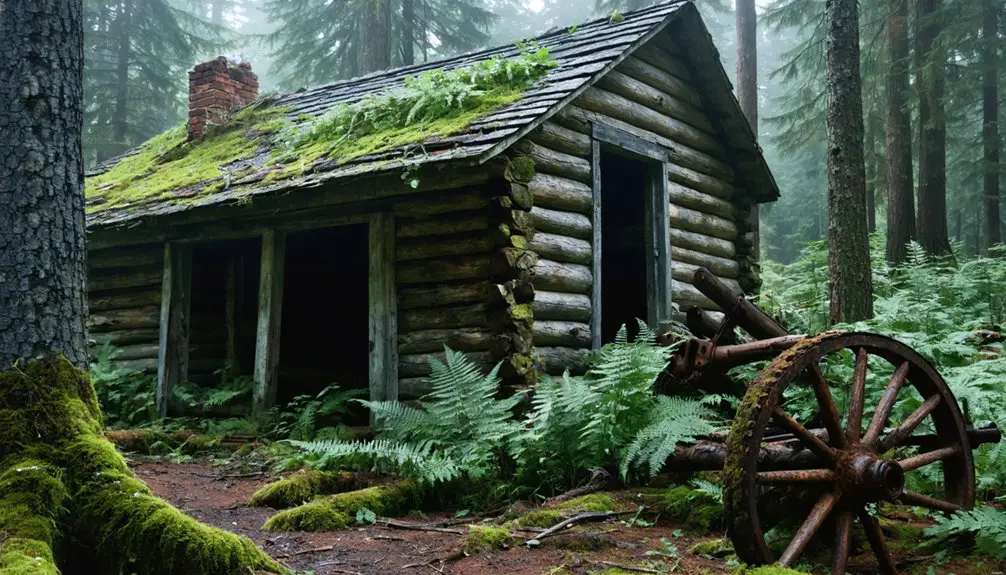You’ll find Nesbit Run among Pennsylvania’s most intriguing ghost towns, where coal once fueled a bustling community. After the Nesbitt family sold the land in 1865, the Pittsburgh Coal Company built a company town that produced 6,000 tons of anthracite daily by 1914. The town’s 440 miners shared just 14 houses, living under strict company control. Today, only scattered remnants survive, including a decaying municipal building and firehouse, while underground mine fires tell a deeper story.
Key Takeaways
- Nesbit Run transformed from a thriving coal mining community into a ghost town following the early 20th century Great Migration.
- The Pittsburgh Coal Company established the town in 1865, reaching peak production of 6,000 tons of coal daily by 1914.
- Underground mine fires and hazardous conditions made reconstruction impossible, leading to widespread building abandonment and collapse.
- Only a deteriorating municipal building, firehouse, and some churches remain as physical evidence of the former community.
- Historical documentation, including maps, photographs, and archives, preserve the memory of this Pennsylvania ghost town.
The Rise of a Coal Mining Community
When the Nesbitt family sold their land to coal entrepreneur Peter Hormel in 1865, they set in motion the birth of what would become Nesbit Run‘s thriving coal mining community. Hormel’s establishment of the Beechmont Coal Company tapped into rich anthracite seams, following the region’s proven mining success since John Smith’s groundbreaking discoveries in 1811. The Pittsburgh Chartiers Youghiogheny railroad played a vital role in transporting coal from the mines to market destinations. You’ll find that community growth paralleled mining expansion, as the Rochester & Pittsburgh Coal & Iron Company developed essential infrastructure. The mining operations grew rapidly, reaching an impressive output of 6000 tons daily by 1914.
Life in the Company Town
Life in Nesbit Run centered around the Pittsburgh Coal Company’s firm grip on daily affairs, a reality shared by mining families across Pennsylvania’s coal country.
You’d find yourself living in one of just 14 houses, working alongside 440 fellow miners in dangerous underground conditions. The community dynamics revolved around company-owned facilities – a brick store where you’d buy necessities, a theater for entertainment, and a school for your children.
Your economic dependency on the company was nearly complete. They owned your home, controlled your wages, and provided the goods you’d purchase.
From paycheck to pantry, the coal company held the keys to every aspect of miners’ financial existence.
While the three-story hotel and electric-powered mines suggested progress, you’d still face the harsh realities of company town life: limited autonomy, long hours underground, and the constant reminder that your livelihood depended entirely on the coal company’s success. Born in nearby Tarentum, Pennsylvania, model and actress Evelyn Nesbit would later gain fame far beyond these coal mining regions. The Beam Papers collection provides detailed documentation of these mining operations and their impact on local communities from 1913 to 1945.
The Great Migration and Decline

During the early 20th century, Nesbit Run’s decline paralleled a transformative period known as the Great Migration, as African Americans fled the violent Jim Crow South for Northern industrial centers.
Migration patterns shifted dramatically as people abandoned isolated company towns for opportunities in Pennsylvania’s urban areas. Many followed the example of pioneering civil rights advocate William Nesbit, who had helped establish African American communities in places like Altoona decades earlier. Higher wages of up to $5 per day in Northern cities attracted workers seeking better economic opportunities.
The changing demographics brought significant cultural shifts to the region:
- Former residents left Nesbit Run for cities like Philadelphia and Pittsburgh, where they’d find more diverse employment options.
- Industrial decline accelerated the town’s abandonment as coal operations became less profitable.
- Those who stayed witnessed their community’s gradual transformation from a bustling company town to a quiet ghost town.
These changes reflected broader societal transformations as Pennsylvania’s urban centers grew while rural mining communities faded into history.
Physical Remnants and Lost Buildings
Remnants of Nesbit Run’s once-vibrant community stand as silent witnesses to its former glory.
You’ll find the municipal building and firehouse among the few surviving structures, though they’re showing signs of architectural decay. Nature’s steady urban reclamation is evident in the cracked streets and overgrown sidewalks that once bustled with activity.
The town’s original residential rows, built as interconnected townhouses, have largely collapsed due to the domino effect of selective demolition. Toxic gases from the underground mine fire continue to make the area hazardous for reconstruction efforts.
Like the abandoned Landing Tavern that served travelers and boatmen until 1873, many historic buildings were left to deteriorate as the town declined.
You can still trace the former street layout through exposed foundations and utility remnants, while surviving houses now require external supports to remain standing.
Churches situated outside hazardous zones offer rare glimpses of intact architecture, though they too battle against the relentless forces of weather and vegetation.
Preserving the Memory of Nesbit Run
While the physical structures of Nesbit Run fade into nature’s embrace, the town’s memory endures through meticulous documentation and preservation efforts.
Through community engagement and digital storytelling, you’ll find the town’s legacy lives on in multiple ways:
- County archives, university collections, and newspaper records maintain detailed accounts of daily life, while oral histories from former residents’ descendants provide intimate glimpses into the community’s past. Similar to Centralia, where toxic gases forced residents to relocate, environmental hazards played a key role in the town’s abandonment.
- Local historical societies and educational programs keep Nesbit Run’s story alive through exhibitions, lectures, and documentary films that showcase the town’s role in Pennsylvania’s coal mining heritage. Like many coal towns that declined, Nesbit Run saw its final days when the mines closed in 1934.
- Online platforms and digital archives guarantee future generations can access maps, photographs, and historical documents, while social media groups create spaces for sharing memories and research about this vanished coal town.
Frequently Asked Questions
Were Any Paranormal Activities Reported in Nesbit Run After Its Abandonment?
Like whispers in forgotten halls, you’ll find ghost sightings and urban legends swirling around the area, with reports of blue orbs, mysterious music, and unexplained sounds haunting abandoned homes.
What Happened to the Cemetery and Burial Records From Nesbit Run?
You’ll find little cemetery preservation occurred – the handmade cement markers deteriorated, and vandals damaged what remained. Most burial records weren’t centrally archived, though some Nesbit family graves relocated to nearby church cemeteries.
Did Any Famous People or Notorious Criminals Come From Nesbit Run?
You won’t find any famous residents documented from this town. While nearby Whiskey Run had some notorious events, including an unsolved 1927 double murder, Nesbit Run’s people dispersed quietly by 1934.
What Native American Tribes Originally Inhabited the Nesbit Run Area?
You’ll find the Susquehannock were the first inhabitants, followed by the Lenape Tribe in the 1690s. Later, the area saw influence from the Iroquois Confederacy, particularly Seneca and Cayuga peoples.
How Did Residents Receive Medical Care in Nesbit Run’s Remote Location?
You’d receive initial care from local doctors at home, then get medical transport to Nesbitt Memorial Hospital, which opened in the 1910s to improve healthcare accessibility for remote residents.
References
- https://www.iup.edu/library/departments/archives/coal/mines-and-company-towns/the-company-town-of-whiskey-run.html
- https://indianacountyparks.org/our-trails/ghost-town-trail/ghost-town-trail-history/
- https://www.youtube.com/watch?v=Qj5LjacccJ0
- https://pabucketlist.com/the-spookiest-sounding-destinations-in-pennsylvania/
- https://en.wikipedia.org/wiki/List_of_ghost_towns_in_Pennsylvania
- https://en.wikipedia.org/wiki/Coal_mining_in_Plymouth
- https://colliertownship.net/township/neighborhoods/
- https://www.iup.edu/library/departments/archives/coal/mines-and-company-towns/the-company-town-of-iselin.html
- https://en.wikipedia.org/wiki/History_of_anthracite_coal_mining_in_Pennsylvania
- https://www.dep.state.pa.us/dep/deputate/minres/bmr/beneficial_use/10 CHAPT 2/Chapter 2 final.pdf



